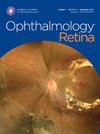Isolated Retinal Neovascularization in Retinopathy of Prematurity
IF 4.4
Q1 OPHTHALMOLOGY
引用次数: 0
Abstract
Objective
Isolated retinal neovascularization (IRNV) is a common finding in patients with stage 2 and 3 retinopathy of prematurity (ROP). This study aimed to further classify the clinical course and significance of these lesions (previously described as “popcorn” based on clinical appearance) in patients with ROP as visualized with ultrawidefield OCT (UWF-OCT).
Design
Single center, retrospective case series.
Participants
Images were collected from 136 babies in the Oregon Health and Science University neonatal intensive care unit.
Methods
A prototype UWF-OCT device captured en face scans (>140°), which were reviewed for the presence of IRNV along with standard zone, stage, and plus classification. In a cross-sectional analysis we compared demographics and the clinical course of eyes with and without IRNV. Longitudinally, we compared ROP severity using a clinician-assigned vascular severity score (VSS) and compared the risk of progression among eyes with and without IRNV using multivariable logistic regression.
Main Outcome Measures
Differences in clinical demographics and disease progression between patients with and without IRNV.
Results
Of the 136 patients, 60 developed stage 2 or worse ROP during their disease course, 22 of whom had IRNV visualized on UWF-OCT (37%). On average, patients with IRNV had lower birth weights (BWs) (660.1 vs. 916.8 g, P = 0.001), gestational age (GA) (24.9 vs. 26.1 weeks, P = 0.01), and were more likely to present with ROP in zone I (63.4% vs. 15.8%, P < 0.001). They were also more likely to progress to stage 3 (68.2% vs. 13.2%, P < 0.001) and receive treatment (54.5% vs. 15.8%, P = 0.002). Eyes with IRNV had a higher peak VSS (5.61 vs. 3.73, P < 0.001) and averaged a higher VSS throughout their disease course. On multivariable logistic regression, IRNV was independently associated with progression to stage 3 (P = 0.02) and requiring treatment (P = 0.03), controlling for GA, BW, and initial zone 1 disease.
Conclusions
In this single center study, we found that IRNV occurs in higher risk babies and was an independent risk factor for ROP progression and treatment. These findings may have implications for OCT-based ROP classifications in the future.
Financial Disclosure(s)
Proprietary or commercial disclosure may be found in the Footnotes and Disclosures at the end of this article.
早产儿视网膜病变中的孤立视网膜新生血管:临床关联和预后影响。
目的:孤立性视网膜新生血管(IRNV)是早产儿视网膜病变(ROP)2 期和 3 期患者的常见病变。本研究旨在通过超宽视场光学相干断层扫描(UWF-OCT)对早产儿视网膜病变患者的这些病变(以前根据临床表现描述为 "爆米花")的临床过程和意义进行进一步分类:设计:单中心、回顾性病例系列:收集了俄勒冈健康与科学大学新生儿重症监护室 136 名婴儿的图像:UWF-OCT原型设备采集全脸扫描(>140°),根据标准区域、分期和加号分类检查是否存在IRNV。在横向分析中,我们比较了有 IRNV 和无 IRNV 眼睛的人口统计学特征和临床过程。纵向分析中,我们使用临床医生指定的血管严重程度评分(VSS)比较了ROP的严重程度,并使用多变量逻辑回归(MLR)比较了有IRNV和无IRNV眼球的病情进展风险:结果:136 名患者中,有 60 名患者发展到了第 3 期:在 136 例患者中,有 60 例在病程中发展为 2 期或更严重的 ROP,其中 22 例在 UWF-OCT 中观察到 IRNV(37%)。平均而言,IRNV 患者的出生体重(BW)(660.1 克 vs 916.8 克,P = 0.001)和胎龄(GA)(24.9 周 vs 26.1 周,P = 0.01)较低,更有可能在 I 区出现 ROP(63.4% vs 15.8%,P < 0.001)。他们也更有可能发展到第三阶段(68.2% 对 13.2%,p < 0.001)和接受治疗(54.5% 对 15.8%,p = 0.002)。IRNV患者的VSS峰值更高(5.61 vs 3.73,p < 0.001),整个病程中的平均VSS值也更高。在MLR中,IRNV与病情进展到3期(p = 0.02)和需要治疗(p = 0.03)独立相关,并控制了GA、BW和最初的1区疾病:在这项单中心研究中,我们发现 IRNV 发生在风险较高的婴儿中,是导致 ROP 进展和治疗的独立风险因素。这些发现可能会对未来基于 OCT 的 ROP 分类产生影响。
本文章由计算机程序翻译,如有差异,请以英文原文为准。
求助全文
约1分钟内获得全文
求助全文

 求助内容:
求助内容: 应助结果提醒方式:
应助结果提醒方式:


